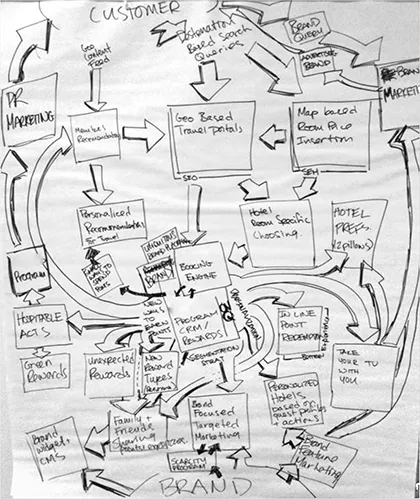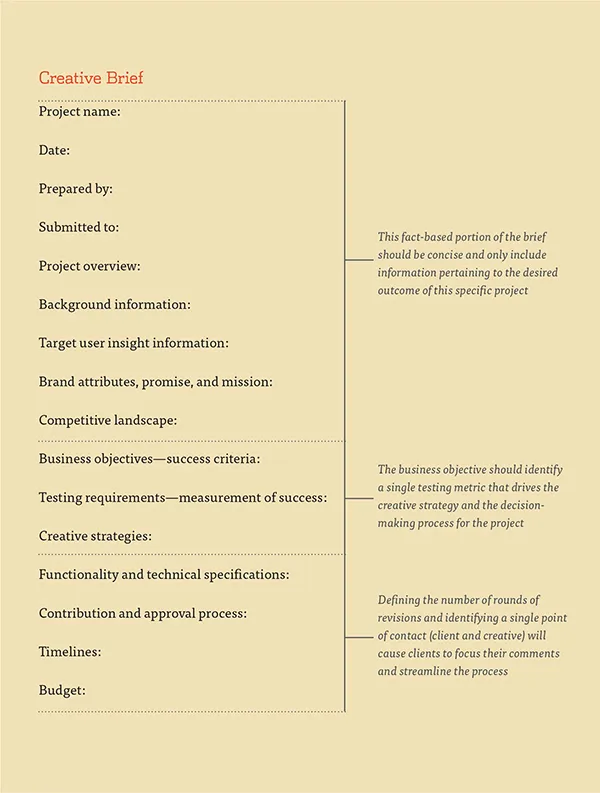
eBook - ePub
Above the Fold, Revised Edition
Brian D Miller
This is a test
Condividi libro
- 272 pagine
- English
- ePUB (disponibile sull'app)
- Disponibile su iOS e Android
eBook - ePub
Above the Fold, Revised Edition
Brian D Miller
Dettagli del libro
Anteprima del libro
Indice dei contenuti
Citazioni
Informazioni sul libro
Above the Fold is a book about the fundamentals of clear graphic communication within the context of Web design. The book has three sections, which follow the cycle of a typical Web project:
- PLAN
Section I focuses on the predesign phase of a Web project. From project planning and brief writing to information architecture and responsive grid creation. - DESIGN
The second section of Above the Fold explores the enduring principles of design and the nuances that are specific to the field of Web design. - OPTIMIZE
Finally, we close the loop and discover ways to enable your client to maximize the investment they've made in their Web site with marketing and analytics.
Domande frequenti
Come faccio ad annullare l'abbonamento?
È semplicissimo: basta accedere alla sezione Account nelle Impostazioni e cliccare su "Annulla abbonamento". Dopo la cancellazione, l'abbonamento rimarrà attivo per il periodo rimanente già pagato. Per maggiori informazioni, clicca qui
È possibile scaricare libri? Se sì, come?
Al momento è possibile scaricare tramite l'app tutti i nostri libri ePub mobile-friendly. Anche la maggior parte dei nostri PDF è scaricabile e stiamo lavorando per rendere disponibile quanto prima il download di tutti gli altri file. Per maggiori informazioni, clicca qui
Che differenza c'è tra i piani?
Entrambi i piani ti danno accesso illimitato alla libreria e a tutte le funzionalità di Perlego. Le uniche differenze sono il prezzo e il periodo di abbonamento: con il piano annuale risparmierai circa il 30% rispetto a 12 rate con quello mensile.
Cos'è Perlego?
Perlego è un servizio di abbonamento a testi accademici, che ti permette di accedere a un'intera libreria online a un prezzo inferiore rispetto a quello che pagheresti per acquistare un singolo libro al mese. Con oltre 1 milione di testi suddivisi in più di 1.000 categorie, troverai sicuramente ciò che fa per te! Per maggiori informazioni, clicca qui.
Perlego supporta la sintesi vocale?
Cerca l'icona Sintesi vocale nel prossimo libro che leggerai per verificare se è possibile riprodurre l'audio. Questo strumento permette di leggere il testo a voce alta, evidenziandolo man mano che la lettura procede. Puoi aumentare o diminuire la velocità della sintesi vocale, oppure sospendere la riproduzione. Per maggiori informazioni, clicca qui.
Above the Fold, Revised Edition è disponibile online in formato PDF/ePub?
Sì, puoi accedere a Above the Fold, Revised Edition di Brian D Miller in formato PDF e/o ePub, così come ad altri libri molto apprezzati nelle sezioni relative a Design e Web Design. Scopri oltre 1 milione di libri disponibili nel nostro catalogo.
Informazioni
Argomento
DesignCategoria
Web DesignSection I
PLAN
1. Web Site Planning
2. Elements of Usability
3. Space, Grids & Responsive Design

Illustration by Bryan Hamilton
CHAPTER 1
WEB SITE PLANNING
User-focused design, or design that puts the user ahead of stylistic design treatments or gratuitous use of technology, must start with a plan. The objective of this plan is to align the client’s business goals with the needs and desires of the target user group. A plan can also help map out a “big picture” view of the project, giving all members of the team perspective, clarity, and a common goal. An effective plan helps remove subjectivity from the creative process and gives a framework for decision-making.
Project Planning
Creating a Web site project plan is a multi-part, multi-disciplinary process. The phases of this process can include research and discovery, content inventory, site mapping, wireframing, usability mapping, prototyping, and design concepting, all of which are discussed in this chapter. Depending on the size of the project, this phase can take a week to several months to establish the documents needed to effectively move forward with the design phase.
There are many benefits to developing an effective site plan. The client should reap long-term benefits, from a reduction in the development cost normally associated with inflexible or flawed systems, to decreased training costs. These benefits help clients make the most of their Web site and achieve the highest return on their investment (ROI).
Plans also help the design team define the parameters of a project for estimating purposes. Once a plan is in place, the designer or project team should have a clear picture of the scope of work (SOW) for the project. The team can then estimate and assign time to each task or phase of the project. If along the way the client has revisions or changes direction, the designer or project team can refer back to the approved plan and determine whether the project needs to be re-estimated or if the alterations are within the original scope of work.
Ultimately, however, site planning should be about the user. The goal of a well-conceived site plan is to increase a user’s satisfaction with a site by organizing information and optimizing the critical tasks on the site. The measure of the ease of use for a site is called usability and is discussed in the next chapter. What follows are the basic steps involved in the Web site planning stage.
Research & Discovery
The process of developing a plan usually starts with research into the client’s goals for the site and an analysis of the landscape in which a site will exist. A briefing meeting is an interview with the client to better understand the purpose behind the project. This can be conducted by a designer or an account executive (also called a client manager), whose job is to manage the client relationship. A SWOT (strengths, weaknesses, opportunities, and threats) analysis can be very helpful in pinpointing the internal and external factors that will influence the project. A SWOT analysis categorizes the internal and external, positive and negative factors that can influence the effectiveness of a site.
To gain a deeper understanding of the landscape, it’s often necessary to conduct a competitive analysis and customer interviews. A competitive analysis results in noting what the competition does well as well as where they fall short. This can help identify gaps in the market that the client can take advantage of. Customer interviews are helpful for identifying the current perception of the client organization or the general feeling of the current market.
The result of a client briefing and customer interviews is a project or creative brief. A creative brief outlines the goals for a project, the special considerations the team must take in order to complete the project effectively, as well as a schedule of milestone events. A brief is usually reviewed by the team and the client and signed off, forming the directional foundation for the project.

This is an example of a SWOT analysis. The process of developing a SWOT chart can help uncover key pieces of information that help shape the usability and concept of a Web site. Strengths and weaknesses are internal factors, while opportunities and threats are external factors that a client has little control over.
A SWOT analysis categorizes the internal and external, positive and negative factors that can influence the effectiveness of a site.
Requirements Documentation
A great way to organize the client’s needs and create a list of success factors is with a requirements document. A requirements document is usually a spreadsheet that contains a list of non-subjective “must-haves” for each page or section of a site as well as global must-haves for the whole site. An example of a requirement is “the site shall have commerce functionality,” or “the main navigation shall include a link to the shopping cart feature.” These requirements help set a framework for the rest of the planning stage and they can be referred to throughout the project to ensure the success of the project.

This creative brief template helps clients synthesize the goals of a project in a way that can help remove a lot of the subje...